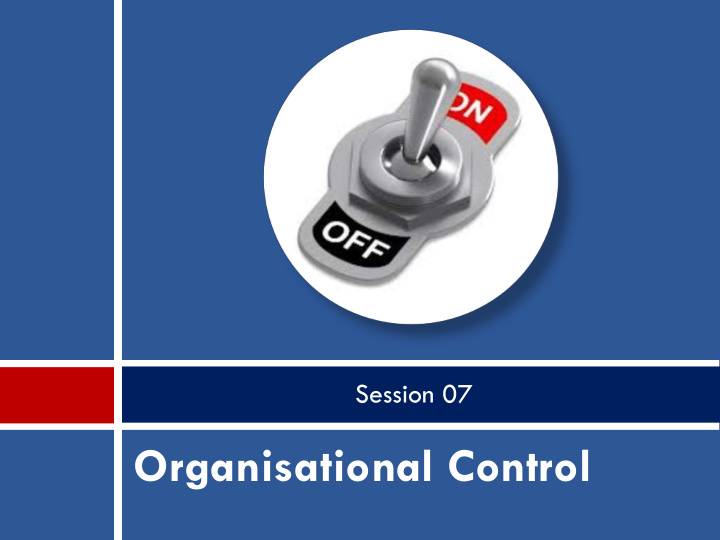



Session 07 Organisational Control
“The movement of an organization might get directed elsewhere due to internal and external influences” Deviation Internal factors External factors
Definition - Organization Control Organisational control is the systematic process through which managers regulate organisational activities to make them consistent with expectations established in plans, targets, and standards of performance
Controlling Points Input Conversion Output Feed-forward Recurrent Feedback • Control on- • Control • Control going Output Input conversions The business process is the flow of work. This total process could be controlled at 3 main points: Input stage (feed-forward) Preventing probable deviations During the conversion (concurrent) Output stage (feedback): Reviewing
C1 – Feed-forward Controls Used to anticipate problems before they arise so that problems do not occur later during the conversion process E.g. Control - Supplier controls - HR controls Input Conversion Finance controls – - Budgets - Machinery controls, etc.
C2 - Recurrent Controls Give managers immediate feedback on how efficiently inputs are being transformed into outputs These will allow managers to correct problems as they arise E.g.’s : Statistical quality control system Conduct meetings (e.g. Daily, weekly, monthly, annually, etc.) Temperature controls in a plant/machinery
Statistical Quality Controls Pick a random sample of products (e.g. 10 donuts) Check whether they are in line with the specifications
C3 - Feedback Controlling Methods Control your output stage – reactive controlling Basic feedback control model Balance scorecard method Financial statements Financial ratio analysis
Feedback Control Model
The Balanced Scorecard Balanced perspective of company performance Integrates various areas of the organisation Managers record, analyze, and discuss the metrics Serves as core management-control system
The Balanced Scorecard
Quality Controlling Quality is the fitness for use in terms of design, conformance, availability, safety and field use - Juran Deming
Total Quality Management (TQM) Infuse quality into every aspect of the business, all day-to-day activities TQM focuses on: Teamwork Increasing customer satisfaction Lowering costs The goal of TQM is zero defects
Hierarchical versus Decentralized Controlling Approaches Hierarchical controls include the monitoring of behavior through rules, policies, reward systems, and written documentation (Theory X type) Decentralized controls based on values and assumptions; rules are only used when necessary (Theory Y type)
Lean Management Combining advanced technology and innovative management processes and using highly trained employees to solve problems, cut waste, improve productivity, quality and customer value Developed by Taiichi Ohno in Japan, and popularized by James P. Womack and Daniel T. Jones in their 1996 book 'Lean Thinking'
Questions to Try What is Balance Scorecard Method ? Discuss the importance of evaluating non- financial performance along with financial performance? “Poor feedforward controlling will lead to difficulties in conversion stage” – explain and justify this statement
The End
Recommend
More recommend